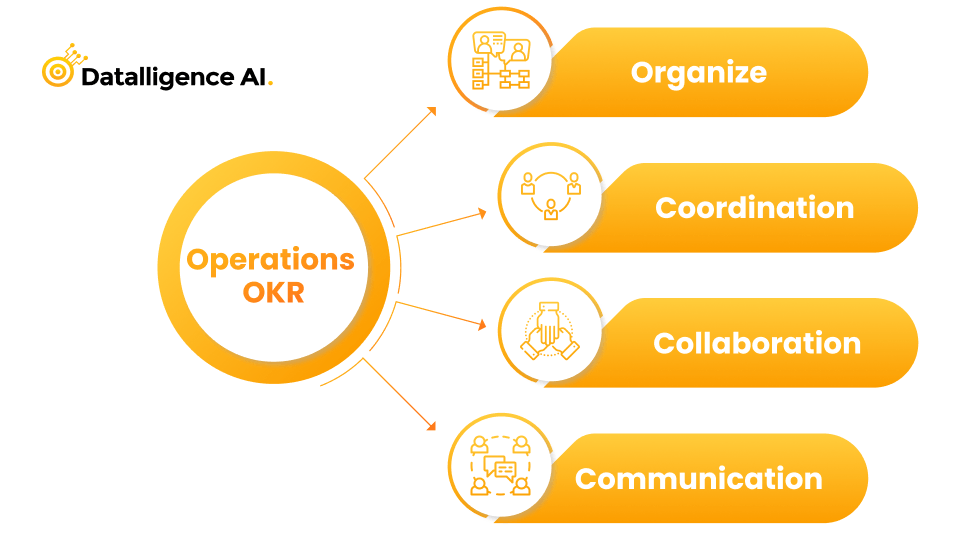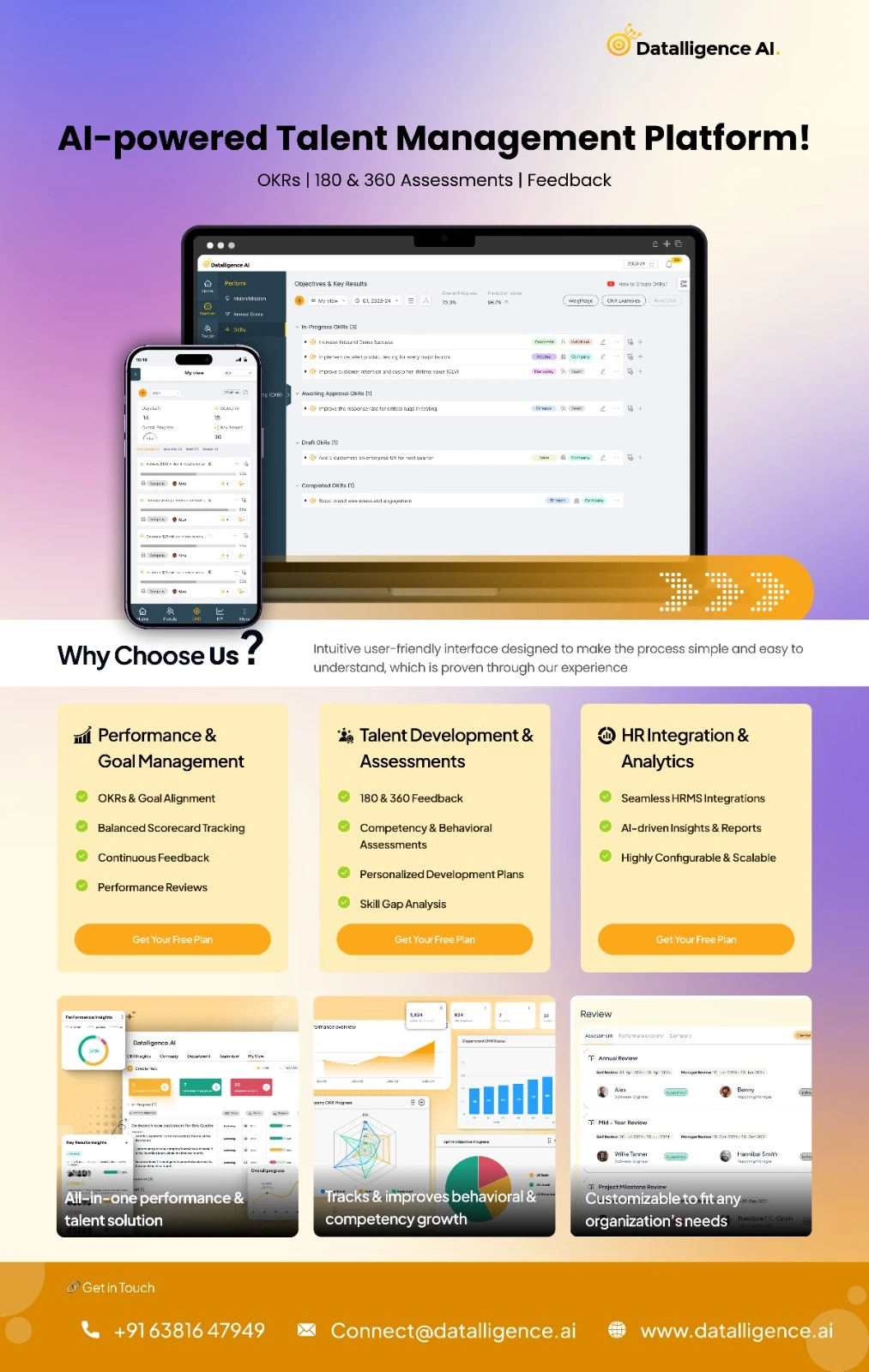Objectives and key results (OKRs) are great for setting ambitious and aspirational goals. These goals will also improve and support day-to-day activities too. OKRs can help to see the big picture as well as an efficient tool for those who are involved in operational roles.
Objective defines “what” we need to achieve and the Key Results define “how” we are going to achieve an objective
OKRs in operations, drive the team in a more efficient and focused manner. This eventually enables reaching the company-wide goals. The seamlessly effective running of the operations is vital as that improves productivity.
How Does Datalligence OKR Software Help Operations, Team
While answering this we can understand the benefits of OKRs and how they will make the processes of the Operations team simple. While OKRs support top-level objects they also work well with bottom-up OKRs.
OKRs software will support the Operations team’s focus and ensure they have aligned with the organization’s critical goal. They can bring in more insights as equal to the other team members. These OKRs are simple yet powerful. They can prioritize and have between 3 to 5 OKRs and a maximum of 5 Key results per objective to increase focus.
These operational teams make the business function effectively.
What are Operations OKRs?

Being an essential cog in the wheel, Operations OKRs support the business realm. There are quite a few metrics available in the operations team that are very crucial to a business. Ensuring that the operations team running smoothly is equal to a business running seamlessly. Therefore it is important to align operations OKRs to align with the goals
OKRs create high-performing teams and they can support the operations team with the following guideline:
- Creating OKRs that create a sense of purpose for its teams
- Create OKRs that help you come out of the Status quo.
- Track and measure the progress of the objectives and maintain alignment
- When OKRs are drafted rightly they support increasing productivity and commitment toward goals.
- OKRs are agile and work well in the dynamic work environment
How do they track these objectives and measure the results?
Operations OKRs are the most effective way to achieve the organizational objective. Consider operational objectives as a destination, meaning the goal that you’d like to achieve. The measurable actions that are taken to reach these objectives are the key results.
Definition of Operations OKRs
It varies according to the type of business and its requirements. To set your OKRs for success, ensure that the objectives are motivational, ambitious, and high-level. They should offer a clear direction toward the goal. OKRs of the operation teams should be goal-driven with measurable key results. Initiatives can also be added to the objectives if they bring in value.
6 Best Examples of Operations OKRs 🚀
Writing good and well-structured Operations OKRs can be a challenge, especially when you have so many metrics being used. While defining Operations OKRs, the team must consider the following questions:
1. How to write good Operations OKRs?
2. What are examples of good operations OKRs?
3. What should be included in Operations OKRs?
Examples of OKRs for Operations.
Objective: Improve operational efficiency and productivity
- KR 1: Reduce overall operational costs by 10% within the next quarter
- KR 2: Increase production output by 15% compared to the previous year
- KR 3: Implement process automation to reduce manual errors and improve efficiency within the next six months
Objective: Enhance supply chain management
- KR 1: Reduce lead time for procurement and order fulfillment by 20% within the next quarter
- KR 2: Improve supplier performance and achieve a supplier satisfaction rating of 90% or higher within the next year
- KR 3: Implement a robust inventory management system to optimize stock levels and minimize stockouts within the next six months
Objective: Ensure quality control and product/service excellence
- KR 1: Achieve a product/service defect rate of less than 1% within the next quarter
- KR 2: Implement a customer feedback loop to gather insights and drive continuous improvement within the next year
- KR 3: Establish and monitor key quality metrics to identify areas for improvement and prevent quality issues within the next six months
Objective: Optimize operational processes and workflows
- KR 1: Reduce process cycle time by 15% compared to the previous quarter
- KR 2: Implement lean principles to eliminate waste and improve process flow within the next year
- KR 3: Conduct regular process audits and implement improvements to streamline operations within the next six months
Objective: Enhance workplace safety and risk management
- KR 1: Reduce the number of workplace accidents by 20% compared to the previous year
- KR 2: Implement safety training programs for all employees and achieve a safety compliance rate of 100% within the next quarter
- KR 3: Develop and implement a risk management framework to identify and mitigate operational risks within the next six months
Objective: Improve customer service and satisfaction
- KR 1: Achieve a customer satisfaction (CSAT) score of 90% or higher within the next quarter
- KR 2: Reduce average response time for customer inquiries by 30% compared to the previous year
- KR 3: Implement a comprehensive customer service training program to enhance employee skills and customer interactions within the next six months
Implement OKR Software solution for the operations Team
While implementing OKRs for the Operations team it is essential to understand the process and key metrics that support achieving the organization’s performance. Setting clear department goals and individual goals is very important as there are various metrics available. Recognizing the key metrics that matter to business will help in crafting OKRs
Talk to our experts more about OKR Software.
Talk to our experts to more about Operations OKRs. Our domain experts can work with organizations to create solutions that are specific to organizations. OKRs are industry agnostic and are very interesting when applied to process-driven Operations teams. The outcome is quantified and hence the results are more tangible. Write to Datalligence for implementing OKRs today or try out Datalligence AI for free.











